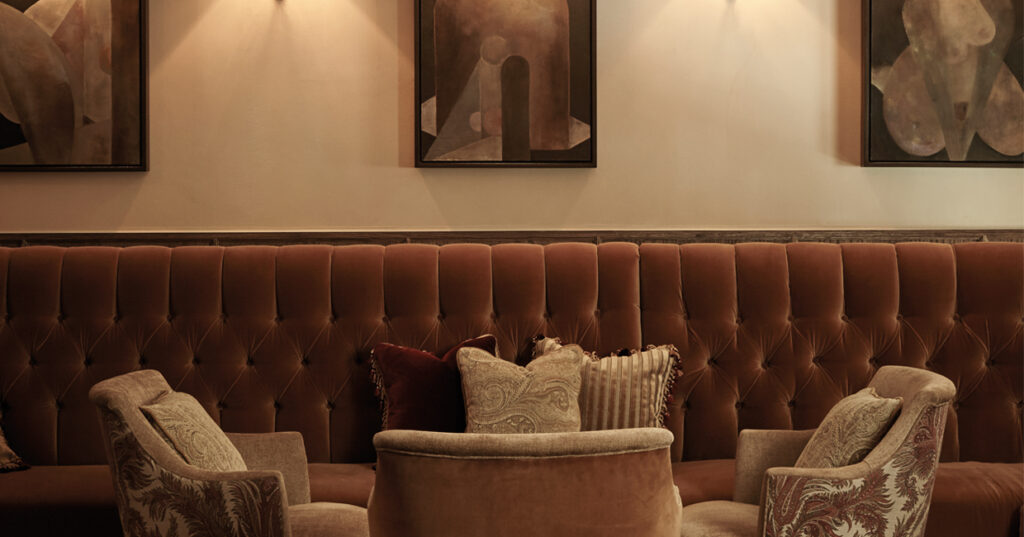Nestled on a charming street directly behind the Royal Danish Theatre, Sanders is formed of two townhouses, fused together into one exceptional, 54-key property. Though brand new, the hotel is woven with a rich cultural tapestry, both in its architecture, and in the passion for theatre and storytelling shared by its owner, Alexander Kølpin.
A former ballet dancer, actor and director, Alexander wished to capture the essence of these creative worlds in order to curate a unique and imaginative guest experience.
“My mother is a fashion designer, my father is an architect, my own background is as a ballet dancer and director, and my family has a history of restoring old buildings to their former glory,” he says.
“I have always wanted to open a hotel combining these worlds; the intimacy of the theatre world, the creativity of the fashion scene, the ambitions of architecture and the musicality of ballet.”
Working in collaboration with London-based interior design studio, Lind + Almond, Alexander has created a classic, yet cosmopolitan venue that, he hopes, will recapture the area’s legacy as a former hotspot for the city’s cultural cognoscenti in the 1970’s.
One of the initial challenges was to consolidate the structure of the property, and the design team have carefully reimagined the layout of the two buildings to ensure it is fit for purpose.
“From the first note to the closing of the curtains, it is all about the journey you take a spectator on. I think about the guest experience at Sanders in a similar way”
“Much of this historic part of Copenhagen is built on land reclaimed from the sea,” explains Lind + Almond co-founder, Pernille Lind. “As such there was initially a great deal of structural reinforcement works to the foundations of the building, to prevent it sinking under its own weight.
“Working with old buildings is a familiar challenge, but in the case of Sanders we needed to work with what was initially three individual buildings. One of our very first tasks was in vastly reducing the number of guestrooms, replacing cramped 3* spaces with ones more fitting of a luxury boutique hotel.
“This meant in some cases amalgamating two rooms into one, whilst spanning between two buildings. We had a big challenge in that the floor levels in the separate buildings frequently misaligned.”
Once the configuration of the hotel was perfected, it was key that the interior should follow suit. “Entering Sanders is like stepping into a theatre,” affirms Alexander. “Guests will always remain centre stage, but the carefully curated interiors will be the elegant and exquisite backdrop for their experience.
“From the first note to the closing of the curtains, it is all about the journey you take a spectator on. I think about the guest experience at Sanders in a similar way.”
The hotel’s reception certainly sets the scene in the way Alexander describes with its spectacular 1940’s vintage chandelier. Designed by iconic architect, Carlo Scarpa, and handmade by the Murano glass masters of Venini, its 300 beautiful glass prisms create a warm, welcoming glow over the reception desk.
Throughout the hotel’s public spaces and accommodation, Lind + Almond has selected a subtle palette of earthy, timeless tones. Stained timber, honed marble, velvet and rattan abound to create a classic feel.
While the woodwork positions the hotel very firmly in Denmark, exotic marble from Italy, Portugal and Greece, slate from the British Lake District and limestone from Croatia bring a cosmopolitan, outward looking ambience.
Indeed, the interiors of the hotel’s restaurant, Sanders Kitchen, reflect on the golden age of travel and the exploration of new places and cultures. Dark green leather seating, rattan and bamboo – blended with flamboyant printed fabrics and furnishings – bring a colonial edge.
“As a take on a theatre bar, Tata references Alexander’s past life as a ballet dancer. It aims to attract artists and creatives, both local and foreign, to mingle as they once did decades ago in the same space”
Within the bar, TATA, Lind + Almond have opted for bolder statements of colour in reference to Alexander’s background in theatre, and of course the hotel’s proximity to the Royal Danish Theatre. Sumptuous red curtains set the stage here, while plush seating and artfully-placed lighting create an intimate, almost seductive feel.
“For me Tata is a real centrepiece, and I’m particularly fond of the concept behind the design,” says Richy Almond, co-founder of Lind + Almond. “As a take on a theatre bar, Tata references Alexander’s past life as a ballet dancer. It aims to attract artists and creatives, both local and foreign, to mingle as they once did decades ago in the same space.”
From theatre bar to rooftop oasis, The Courtyard offers Sanders residents and the public alike a rare rooftop space overlooking Copenhagen’s picturesque rooftops. Here, ivy-covered walls and a garden of exotic plants create an inside-outside feel, coupled with colonial-inspired furniture and a roaring fireplace.
“I must say the 5th floor Orangery is a real design highlight for me,” says Pernille. “Maybe it’s due to my own ‘exotic’ background (being half Thai).”
“Iconic architect Arne Jakobsen designed the Charlottenborg chair and Belladonna sofa, both featured in this space, embracing foreign materials in their use of bamboo. This, along with tropical printed fabrics, lush plants and the indoor/outdoor connection, takes me back to my childhood home.”
Carefully curated artwork provides the finishing touch to the hotel’s interior, capturing the narrative strands of the property’s historical significance, as well as Alexander’s personal history. The collection was sourced by Lind + Almond and commissioned by Alexander in collaboration with art consultancy practice, Dais Contemporary.
Drawing from Copenhagen’s waterfront context, the modernist and expressionist periods synonymous with important works of Danish art and design, as well as Alexander’s love of movement, dance and the human form, this collection of artwork embodies the hotel’s unique philosophy – a blend of national pride with a firmly cosmopolitan perspective.



